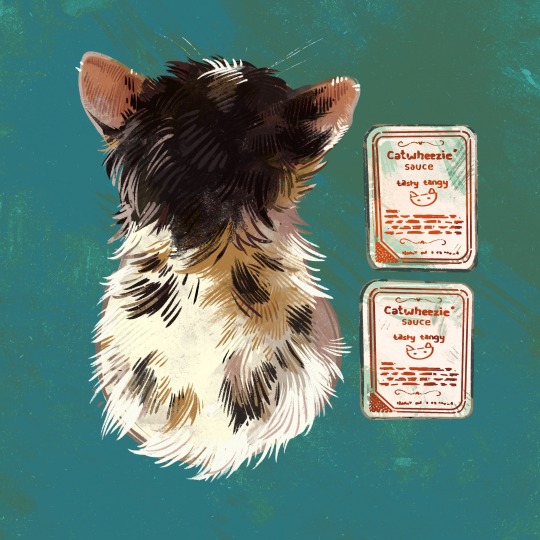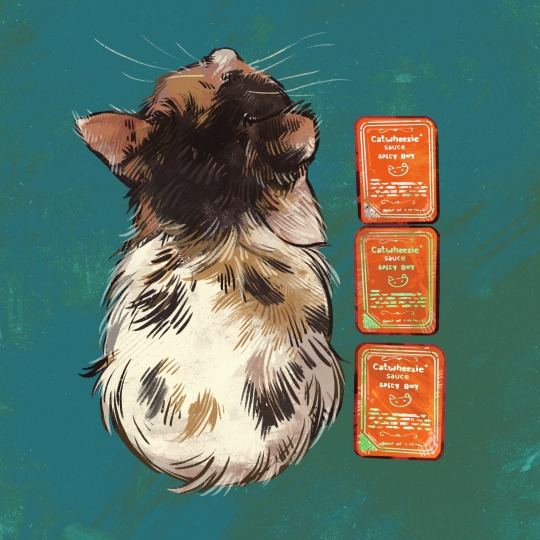Text










Nautilus expedition live streams (+ their commentary) | 2024
34K notes
·
View notes
Text
Seabirds of the Artechocene:
The Anthropogenic Extinction Event was particularly devastating for ocean ecosystems, including the seabirds that relied on it, with only a few species surviving the event. 39 million years later however, life has recovered, and now the descendants of these seabirds, as well as other aquatic birds that took to the seas, are a common sight worldwide, belonging to a variety of different groups:


Full piece of the seabird diversity in the Artechocene oceans
•Vesselbirds (Caravelorniformes):
A widespread group of the largest of the Artechocene seabirds, they have abandoned land completely, brooding being taken care of by a specialised structure on the male's back that acts as a nest.
•Corsairfishers (Piratosagipterines):
Kingfishers relatives that use kleptoparasitism as one of their main feeding strategies, often following larger, more specialised seabirds.

Close-up on the vesselbirds and corsairfishers
•Kitegulls (Milvulari):
Close relatives of cacklers, they are long distance flyers, feeding on surface prey and rarely landing, only to breed on isolated islands across their expansive range in temperate and tropical oceans worldwide.
•Sea Songbirds (Thalassopasseridae):
A unique family of passeriformes found mostly around the southern hemisphere, the scallywags (Pelagopasser sp.) are a genus of open ocean specialists that are found on every ocean except the Arctic, flapping and skimming the surface of the ocean to feed on small planktonic prey.
•Dumingos (Anabalaenidae):
A cosmopolitan group of filter feeding ducks, they are typically found in inland waters, but a few species, like the sea dumingo (Pinnatocetus celer), have been able to exploit its endless amount of plankton.

Close-up on the sea songbirds, dumingos and kitegulls
•Harpansers (Dinomergidae):
Found mostly around the northern hemisphere, these sea ducks are specialised fish eaters that can dive and swim particularly well. Hunting in large groups, they can co-ordinate to hunt down entire schools of fish and squid.
•Seadrakes (Thescelodyptidae):
A family of very diverse, cosmopolitan sea ducks found mostly in cold oceans, that are characterised by their colorful males and hardened papillae inside of of their mouths, specialised for each species' diet. The star-horned squobbler (Magnificodyptes asterotops) in particular is a squid specialist, using hooked papillae and suction to keep its soft bodied prey from escaping.
•Umibozulles (Bathostyxiformes):
A unique offshoot of the full clade native to the Pacific, Arctic and north Atlantic regions, these fully nocturnal seabirds are extremely cryptic and hard to see, leaving their colonies in the middle of the night to dive and incredible depths in search of small invertebrates and fish; using their black, iridescent feathers that appear pitch dark at depth, to go unnoticed by prey.
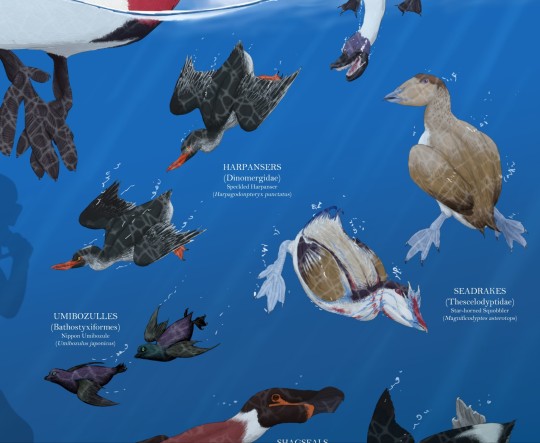
Close-up on the harpansers, seadrakes and umibozulles
•Shagseals (Phociornithiformes):
A flightless order of the cormorant clade, they include the largest seabirds of the Artechocene. This is due to their dense bones, which they use alongside their sensitive beaks to swim hovering just above the seafloor at great depth, coming out to breathe every few hours, thanks to a very efficient circulatory system. Despite being mostly aquatic, to breed they must come out to land, where males use a specialised armpit pouch to brood the eggs and young.
•Balamars (Balaornithidae):
Another cosmopolitan member of the gull clade, they are adapted for speed, being able to plunge dive and pursue prey at incredible velocity.
•Penmorants (Pinguriliiformes):
Another order of flightless seabirds in the cormorant clade, these are much more widespread and pelagic, being able to be spotted in the open ocean in every region, but with the highest diversity being in the northern hemisphere. Unlike vessel birds, these need to come back to land to breed.
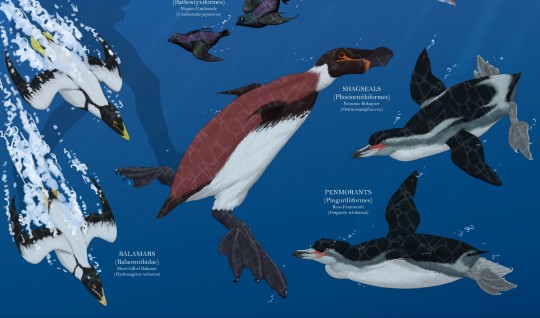
Close-up on the balamars, shagseals and penmorants
•Coast Cacklers (Neolaridae):
A living fossil amongst the full clade, they're generalist predators found in coasts and open seas all across the world, from pole to pole.
•Titan Gulls (Laroposeidonidae):
The largest of the flying seabirds, these long distance flyers can be found on the open ocean across the southern hemisphere and the Pacific Ocean.
•Kelp Ruddies (Phycophaganatidae):
Specialised algae grazing ducks distributed along the cold coasts of every continent except Africa.
•Labrosone Geese (Auloceratidae):
Anseriforms with a uniquely complex nasal structure that amplify and warp their calls, some marine species can be found along the coasts of Afro-Eurasia.
•Windtellers (Aequoelanus sp.):
A small genus of medium sized predators that can be found offshore of coastal forests across the world, lunging on fish too close to the surface.
•Basketgulls (Pelecanoidae):
Another, very voracious, relative of cacklers, found offshore on every ocean except for the arctic. Good flyers, they usually plunge into the water to catch shoals of small prey.

Close-up on the coast cacklers, kelp ruddies, labrosone geese, windtellers and basketgulls
•Bagshags (Euryrhamphinae):
A diving predator capable of gulping down fish larger than itself, these voracious, near flightless birds can be found in coasts and freshwater systems of the tropics and temperate areas of the world.
•Taornes (Hastanhinga sp.):
A pantropical genus highly associated with clamoral reefs and other high diversity, shallow water ecosystems, slowly stalking prey hidden in crevices or substrate with pinpoint precision.
•Seahens (Littogallidae):
Omnivores found in areas not far from the coast of every continent. They are diverse and occupy a wide variety of niches, specialising on different diets depending on the available resources.
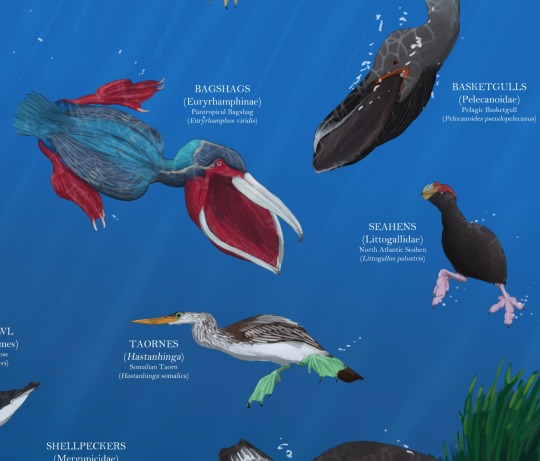
Close-up on the bagshags, taornes and seahens
•Wakageese (Wakaereformes):
A basal offshoot of the waterfowl clade, it has evolved a unique style of swimming and very specialised, hydrodynamic feathering. It evolved isolated on Antarctica soon after it started to thaw, and is now distributed mostly around the southern ocean.
•Shellpeckers (Mergupicidae):
One of the few non-gull marine charadriiformes left, these have taken a rather unique approach to a durophagous diet, using a strong beak and a hammering motion to open the shellfish it dives for.
•Anatorants (Sulanatidae):
A flying, basal offshoot of the phociornithiformes, presenting a similar beak sensitivity as their relatives but less aquatic specialisations. Given their flight capabilities, they're found much more widespread than their northern relatives, extending far into the southern hemisphere.

Close-up on the wakafowl, shellpeckers and anatorants
•Mergeese (Sirenianseridae):
Aquatic grazers very specialised for their lifestyle, with a large crop that is used for fermenting the plant material. Because of this diet, they're highly associated with seagrass meadows in the Indo-Pacific, Caribbean and European regions.
•Sandabblers (Psammobenthavinae):
A cosmopolitan anatid subfamily of diving soft sediment specialists that can be found in both fresh and saltwater ecosystems, but the majority are often associated with soft sediment ocean shores.

Close-up on the mergeese and sandabblers
Hope you liked this compilation of Artechocene seabird diversity!!
1K notes
·
View notes
Text
if you need us the missus and me will be in the other room having a duel with old flintlock pistols missing each other with every shot not only because we love each other but also because we both are dog shit at this
27K notes
·
View notes
Text
prog rock is actually short for pregnant dog rock
4K notes
·
View notes
Text
i havent seen these photos hit tumblr yet so i have to share these (creds to @/draculoidzz on twt)


966 notes
·
View notes
Text
'mobsters' are part of a 'mob'. and so you'd think 'lobsters' would be part of a 'lob', but ohohohhohoho, life just isn't so simple
132K notes
·
View notes
Text


gerard way [ my chemical romance ] as a charged creeper [ minecraft ]
1K notes
·
View notes
Text

“Last warning”
Sea Lion
by Luis Alberto Da Camino, Brazil
The 35 Photography Awards
30 notes
·
View notes
Text
Going into this bio exam knowing brown eyes are dominant, blue eyes are submissive, and that punettes are square. Wish me luck!
33K notes
·
View notes
Text

you're not trying hard enough
#85 of my top 100 songs 2024: reptilia by the strokes
28 notes
·
View notes
Text
a really key part of any healthy relationships is nonsexual biting. it’s really important to just bite each other sometimes. it will keep your relationship alive biting is the stuff love is made of
24K notes
·
View notes





